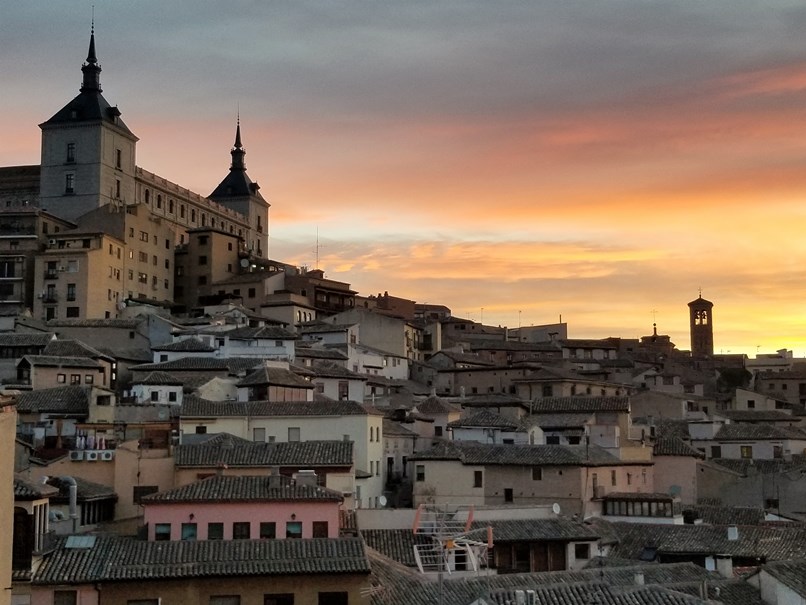Toledo – Spain
Toledo sits atop a gorge in the Castilla la Mancha region, at the center of Spain. Named Toletum by the Romans, Toledo’s history is thought to have begun in the 5th Century when it was settled by Jewish travelers. Ruled by the Visigoths until the Moors conquered the Iberian Peninsula in the 8th Century, Toledo fell to King Alfonso VI in the Christian conquest of Moorish Spain in 1085. It became the capital of Spain until the mid-16th Century when Philip II of Spain moved his court to Madrid.

Today Toledo is referred to as the “City of Three Cultures,” where the remnants of three medieval traditions, religions, art, architecture, and craft are intertwined in a tangle of ancient lanes. Jews, Muslims, and Christians coexisted here for several centuries. The remains of their distinct cultures imbue the town with its evocative appeal.
Enter Toledo via La Puerta de Bisagra – the impressive fortified main entrance to the town. It was built in the 10th Century during Moorish times; however, most of what one sees today was rebuilt by the Spanish in the 16th Century.

The Gothic style Cathedral is the unrivaled centerpiece of Toledo. Its colossal interior, flying buttresses, rose windows, opulence, and ribbed vaults are spectacular. Not to be missed is the artwork of the revered masters Velázquez, Goya, and El Greco.

While El Greco is often assumed to be a son of Spain, he was born in Crete – Greece, hence the name El Greco – The Greek. El Greco made Toledo his home in his mid-thirties and spent most of his life there producing his world-renowned paintings.
The El Greco Museum, which opened in 1911, is located in the Jewish Quarter. The museum attempts to recreate El Greco’s home, which no longer exists and displays a fine collection of his mannerist paintings.

The Sephardic Synagogue, now a museum, was built between 1336 and 1357 by Samuel Halevi, who held several important positions in King Pedro I of Castilla’s court. After the expulsion of the Jews from Spain in 1492, the Catholic Kings gave the synagogue to the Order of Calatrava as a hospital for its members. Over the centuries, it became a church and was subsequently used as military headquarters during the Napoleonic Wars. In 1877, it was declared a national monument, and in 1992 the restoration of the synagogue into a Sephardic museum was completed.

The magnificent Moorish-style lacey plasterwork; the three delicate arches that frame the ark that would have held the Torah scrolls; the Hebrew writing between the geometric patterns and inscriptions of the Mudéjar craftsmen; and the Christian sacristy with an imbedded door and archway – are perhaps one of the finest examples of the blend of Jewish, Moorish, and Christian religions in Toledo.



Mezquita del Cristo de la Luz is a former mosque built in 999AD on the foundation of a Visigoth church. It stands in the neighborhood of Toledo, known as the Medina in Moorish times. Incredibly, this ancient mosque has been preserved in its original state. In the 12th Century, it became a Christian chapel when an apse was added, and it was decorated with Christian artwork. Today it is the oldest surviving mosque in Spain.

The Alcázar, a stone fortification located in Toledo’s highest and most strategic area, was entirely rebuilt by General Francisco Franco after its destruction during the siege of Alcázar during The Spanish Civil War. Today it’s an extensive military museum.

Spend a couple of days in Toledo, discovering its rich history while you wander its lively, picturesque, pedestrian lanes.


As far back as 500BC, Toledo has been known for manufacturing steel weapons, particularly swords. As you explore the town, you’ll come across a multitude of stores selling swords. The high-quality ones are works of art, while the mass-produced ones make for memorable tourist trophies.

Toledo is also famous for its Damascene jewelry, which is believed to have originated in the Middle East. The process involves inlaying oxidized steel with threads of gold and silver to create delicate and intricate patterns. If you choose to purchase Damascene jewelry, be aware that there are those fine pieces made by skilled artisans who have inherited the technique from past generations, and then there is an abundance of factory-made knock-offs.


Old Town has several historic buildings that have been transformed into small, unique accommodations. We stayed at Hospederia Casa de Cisneros, an 11th century Muslim Palace, which in the 16thCentury became the home of Cardinal Francisco Jiménez Cisneros .The renovated house has ten cozy, utterly beguiling rooms with wood-beamed ceilings and gleaming wood floors and furniture. The bathrooms are small but expertly designed to blend with the old-world charm.



From our little balcony on the second floor, I felt as though I could almost reach out and touch the Cathedral walls. The basement restaurant stands on a glass floor that reveals stones believed by archaeologists to be part of the original Muslim Palace.

From the rooftop terrace, one is at eye level with the Cathedral’s spires and has a splendid, unobstructed view of the Alcázar stone fortress.

The staff could not be kinder or more helpful. Breakfast is served in the intimate café off the tiny lobby.
Note: Mudejar art flourished in Southern Spain between the 11th and 16thCenturies after the reconquest of Spain by the Christian Kings. It is a unique fusion of Muslim, Jewish, and Christian art.
